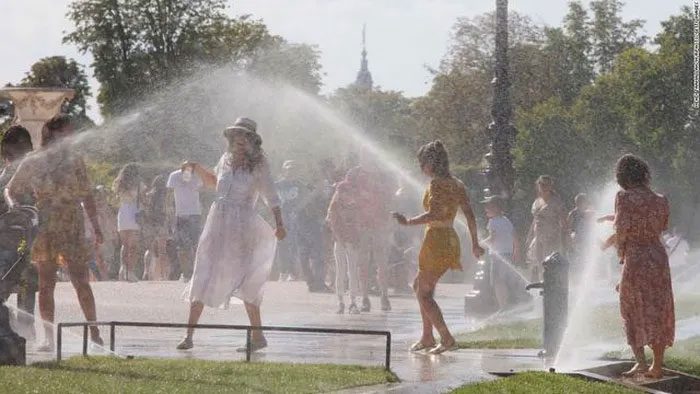The world is striving to find effective solutions to cope with a harsh, sweltering summer influenced by climate change.
Global Heat Mitigation Solutions
According to CNN, extreme heat has returned to Western Europe, with some countries entering their third heatwave of the year. In the United States, over 80% of the population is expected to experience record-breaking heat next week, including areas near the Atlantic and the Northeast.
The climate crisis is causing extreme heat to occur more frequently and last longer. In urban areas, a lack of effective cooling measures can make life increasingly unbearable. Air conditioning may cool indoor spaces but raises outdoor temperatures, contributing to the climate crisis. Traffic congestion is also making the air outside harder to breathe.

Vienna also has many fountains for residents to drink from anytime. (Photo credit: CNN).
Here are some solutions countries are implementing to cope with a scorching summer:
Increasing Green Spaces
As temperatures rise, those who use air conditioning may stay indoors, but not everyone has access to this convenience. In large cities not located near the coast, shaded parks are the best option. Colombia’s second-largest city, Medellín, is developing a shaded urban area through the award-winning “Green Corridor” project.
The “Green Corridor” network has designed bike lanes and tree-lined walkways connecting the city’s parks, becoming a popular destination for residents. Thanks to this project, temperatures have decreased more in areas with greenery and their surroundings.
“Developing urban forests is the best way to reduce heat in the city. This approach helps Medellín lower its average summer temperatures. This is noteworthy,” said Kathy Baughman McLeod, director of the Adrienne Arsht-Rockefeller Resilience Center at the Atlantic Council. In 2019, the city planted over 8,000 trees and more than 350,000 shrubs.
Additionally, in many cities, waiting for the bus can take a long time, and the hotter it gets, the more exhausting the wait becomes. Miami has recognized the importance of planting trees around its 10 bus stops. The project guides suitable types of trees to plant near bus stops, helping residents cool off during the summer. The city now boasts dozens of green bus stops.
Cities around the world are also creating “sky gardens” to reduce heat for buildings.
Misting Systems
Like several European countries, many residents in Vienna, Austria, do not have air conditioning, making water an essential resource for the capital’s inhabitants to cool off in the summer heat. For those who do not have time to soak in the Danube River, the city has built cooling parks with misting columns that allow people to cool off or simply sit nearby to enjoy the cooler temperatures. Children, who are particularly vulnerable to extreme heat, often find joy in the city’s splash pads or running around areas where water sprays up. The city government focuses on water cooling tools to maximize refreshing effects, helping residents avoid heat shock in the summer.
Moreover, Vienna has many drinking fountains available for residents—over 1,100 fountains for a population of 1.9 million— which is crucial in preventing heat-related illnesses.
“Air conditioning at home seems like a quick and easy solution, but it is not sustainable due to energy use and waste heat from these devices. Therefore, utilizing water features and opening windows in older buildings is the best solution for extreme temperatures,” McLeod said.
Similar to Vienna, Paris also employs misting systems during hot days. The capital has dozens of new “fountains” alongside traditional fountains. Additionally, Paris’s heat mitigation plan includes creating an online registry to identify the most vulnerable individuals. Local authorities can check in via phone and provide tailored advice. Kindergartens have temporary air conditioning in classrooms, while parks and public pools remain open for extended hours at night. Like Los Angeles, Paris is also working to cool down its streets and sidewalks by “de-mineralizing,” using more porous materials.
Applying Ancient Cooling Techniques
The Middle East is home to some of the hottest inhabited areas on Earth. Temperatures in Abu Dhabi can exceed 50 degrees Celsius. Air conditioning is considered a necessity, and people often stay indoors to cope with the heat. For those without access to air conditioning, ancient Arabic cooling techniques are an optimal choice.
Mashrabiya is an intricately carved wooden screen placed outside or inside a building. This architectural feature in Islamic design helps diffuse sunlight while keeping the building cool without blocking all light. Mashrabiyas are designed to allow gentle breezes to enter, keeping the room cool and protecting it from excessive heat. Essentially, the idea is to prevent direct sunlight from hitting the exterior of a building. This technique has helped reduce the need for air conditioning by 50% in buildings.
Los Angeles: Painting the City White
This method is somewhat controversial. Some cities have experimented with painting rooftops white to better reflect sunlight and keep buildings cool. However, Los Angeles has taken it a step further by painting all its streets white. Dark asphalt absorbs sunlight and emits heat energy. By painting the asphalt white, the theory is that it will prevent heat from radiating and help keep air temperatures cooler.
Researchers like Ariane Middel and V. Kelly Turner have found that this technique has cooled the streets, helping to lower temperatures by about 10 degrees Celsius during hot weather. This means that if you are a few blocks away, the white streets can help you feel cooler.
Naming Heat Waves
For decades, the world has been naming storms, tornadoes, and hurricanes for a reason: a named storm captures more attention. Spain named the July heatwave Zoe.
“In addition to physical interventions for heatwaves, naming heatwaves is a proactive measure because it helps us recognize their danger levels and be more vigilant,” said Kathy Baughman McLeod, representative of Arsht-Rock.



















































